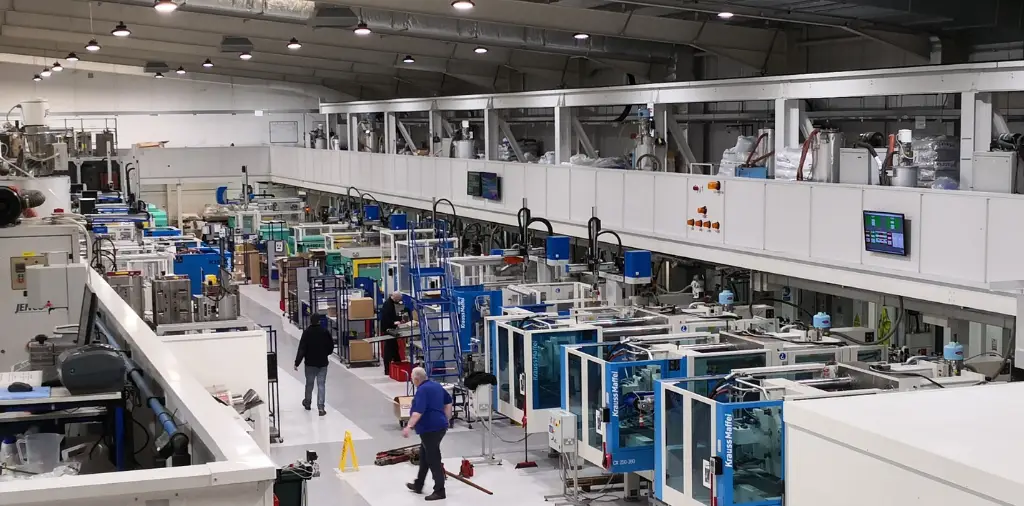Innovative and advancing markets continually require manufacturers to create more cost-competitive and higher-quality products and solutions. To maintain their competitiveness, manufacturers must keep developing new products. Using manufacturing partners to simplify end-to-end production systems is a key strategy to keep pushing development forward.
Here, the integration of box build assembly and plastic injection moulding processes can be an effective area of integration and optimisation. Often, the various phases of manufacturing complex components such as electronic devices and medical technologies are split across several different processes and suppliers spanning multiple different sites. One might be responsible for manufacturing the plastic housing, while another may be responsible for component assembly.
That multi-phase, multi-supplier approach can have several drawbacks. Indeed, every handover risks introducing delays, miscommunications, and quality issues that might introduce new issues or derail production entirely.
By instead bringing box build assembly and plastic injection moulding under one roof, firms can achieve faster turnarounds and more streamlined, seamless paths from production to completion.
What do plastic injection moulding and box build assembly involve?
Today, the manufacturing of plastic components often begins with plastic injection moulding. As its name suggests, molten plastic is injected into specifically designed mould, enabling complex, high-quality components to be produced at scale.
For many sectors, this has been game changing. Manufacturers can now produce critical components for key, complex devices – from handheld diagnostic tools to industrial control units – with incredible accuracy and consistency.
With that said, the production of these individual plastic parts forms just one part of the manufacturing process. Once all the various pieces of a product have been created, they in turn need to be assembled – a complicated process that often involves hundreds of components, wiring, displays and other subassemblies.
This is where box build assembly comes in. It is the process through which all these various elements are integrated into the final, finished solution, ready to be packaged up and shipped to customers.
The value of combining box build assembly with injection moulding
So, what exactly are the benefits of bringing these complementary manufacturing processes into one seamless, integrated production line? Crucially, there are several:
- Production timelines shrink thanks to the elimination of external dependencies.
- Quality improves with a single team managing the entire production process from start to finish.
- Costs come down through waste reductions, minimised logistics, fewer defects, and more efficient workflows.
- Flexibility improves, enabling design changes to be implemented more easily and quickly.
- Scalability is easier and simpler as a single organisation is orchestrating the entire supply chain
In simple terms, end-to-end manufacturing operations can optimise every stage of the component production, assembly and finishing cycle – reducing risks and improving control and visibility to deliver faster, better results. Not only does localisation cut down on idle time and logistics requirements, but it can also improve quality assurance and accelerate time to market.
Combining injection moulding and box building in electronics and healthcare
This integrated approach can benefit a wide range of industries. However, it has particular value for industries such as electronic and medical device manufacturing where precision is essential.
- Electronic devices: Bringing box build assembly and plastic injection moulding together under one roof can make it easier to ensure that complex components such as enclosures, PCBs, and wiring come together seamlessly. Additionally, complementary services can be incorporated into the end-to-end manufacturing process, such as electrical testing.
- Medical devices: Medical devices can both be produced and assembled in cleanroom environments to minimise contamination risks – a critical factor in the success of many surgical or implantable devices. Equally, when everything is controlled under one roof, traceability and compliance become significantly easier to manage and document.
Facilitating world-class moulding and assembly for our clients
As manufacturers continue to evolve and innovate, developing smarter, more compact, more efficient, more easily scalable manufacturing processes will only continue to grow.
OEMs that embrace integrated, end-to-end systems incorporating both injection moulding and box assembly will be well placed to gain an edge, capable of delivering exceptional products in a faster, more agile, more reliable manner.
At OGM, we’re proud to be able to facilitate this for our customers, combining crucial manufacturing processes to simplify supply chains, accelerate development of production and accelerate production lead times. We serve a variety of medical devices and consumer electronic manufacturers, providing tailored solutions across a range of applications – from diagnostic equipment and monitoring systems to electronic scanners and smartphones.
Quality control within our production systems is one of our core priorities. We adhere to ISO 9001:2015 (manufacturing), ISO 14001:2015 (environment) and ISO 13485:2016 (medical) standards, among others.
Are you ready to discuss how integrating injection moulding and box assembly could enhance and futureproof your production processes? Contact our team for a consultation to discover how our injection moulding services and box building solutions can support your business objectives.

